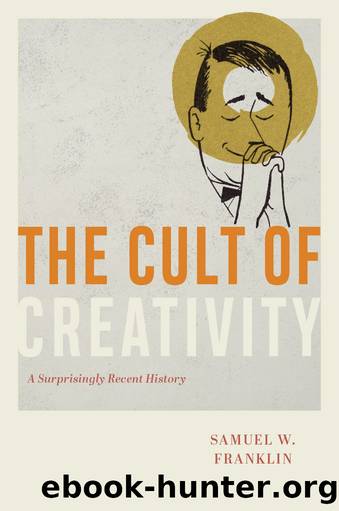The Cult of Creativity by Samuel W. Franklin;

Author:Samuel W. Franklin; [Franklin, Samuel Weil]
Language: eng
Format: epub
Tags: HIS000000 HISTORY / General, HIS036060 HISTORY / United States / 20th Century, HIS054000 HISTORY / Social History, BUS077000 BUSINESS & ECONOMICS / Corporate & Business History
Publisher: University of Chicago Press
Published: 2023-04-17T00:00:00+00:00
6
Revolution on Madison Avenue
The January 1959 issue of Printersâ Ink, one of the two main organs of the American advertising industry, compiled a slew of daunting problems facing the industry. Despite being in the midst of an era of unprecedented billingsâtotal annual advertising expenditures more than doubled between 1947 and 1957, and would almost double again over the next ten yearsâthe recession of 1958 had shrunk advertising budgets and ad execs didnât know if or when they would recover. Apparently there was growing âskepticismâ among manufacturers about whether advertising even worked, and it was decided that agencies needed to do a better job of explaining to their clients why they deserved money that could otherwise go into sales or R&D. One of the sources of skepticism, it was thought, was oversaturationâan ironic effect of Madison Avenueâs successâwhich meant each individual ad needed to work especially hard to distinguish its clientsâ products from the crowd. âThe average American is on the receiving end of up to 1,500 ad impressions daily,â the piece read. âThe ad message that shines through the mass must be exceptional.â1
Adding to these nuts-and-bolts problems was the issue of advertisingâs âunfortunateâ public image problem, about which executives had been âfrettingâ in the wake of Vance Packardâs bombshell exposé The Hidden Persuaders. The ad industry had been the target of skeptics and muckrakers since its beginnings in the late nineteenth century. But in the 1950s Packard led a new flood of criticism that, dovetailing with Cold War political fears, cast Madison Avenue as a force of conformity, soulless consumerism, and quasi-totalitarian mind control. Printersâ Ink considered this image problem a real existential threat, blaming it in part for an impending Federal Trade Commission âcrack downâ and, under a newly liberal Congress, Senate investigations into some of its shady practices.
The cure? Creativity. Creativity would be âthe agencyâs key to â59,â Printersâ Ink declared, predicting it would âassume a new, much more important role.â2 Walter Guild, president of a San Francisco agency, explained how this ânew emphasis on creativenessâ would address the industryâs multiple woes. It would, first, improve the quality of ads themselves. âToo much advertising is just plain dull!â he wrote, echoing the consensus among both advertising professionals and their critics. Clients âare increasingly aware and covetous of âcreativeâ advertising, and increasingly weary of the other kind.â Creativity was, as the editors put it elsewhere in that issue, âthe force that makes a product, a campaign, a company, a commercial or a thought stand above the crowd.â3
Such âcreativeâ advertising would, Guild explained, be accomplished only by liberating âcreativeâ peopleâcopywriters and artistsâfrom the tyranny of the organization. As PI also noted, Madison Avenue was falling prey to the same bureaucratic bloat that infected the rest of America. A âmerger splurge,â as top agencies competed to match the growing size of clients (who, in an attempt to dodge antitrust laws, were undergoing a merger splurge of their own), caused agencies to balloon, with larger teams, more middle managers, more meetings.4 Draper
Download
This site does not store any files on its server. We only index and link to content provided by other sites. Please contact the content providers to delete copyright contents if any and email us, we'll remove relevant links or contents immediately.
Pale Blue Dot by Carl Sagan(4001)
The Rules Do Not Apply by Ariel Levy(3906)
Goodbye Paradise(2964)
Delivering Happiness by Tony Hsieh(2922)
Liar's Poker by Michael Lewis(2812)
Into Thin Air by Jon Krakauer(2701)
Purple Cow by Seth Godin(2698)
Ogilvy on Advertising by David Ogilvy(2682)
Rogue Trader by Leeson Nick(2473)
The Airbnb Story by Leigh Gallagher(2371)
The Social Psychology of Inequality by Unknown(2311)
The Mind Map Book by Tony Buzan(2082)
Six Billion Shoppers by Porter Erisman(2000)
Bossypants by Tina Fey(1987)
All the President's Men by Carl Bernstein & Bob Woodward(1962)
Claridge's: The Cookbook by Nail Martyn & Erickson Meredith(1962)
Master of the Game by Sidney Sheldon(1881)
Alibaba by Duncan Clark(1755)
Wild Ride by Adam Lashinsky(1658)
